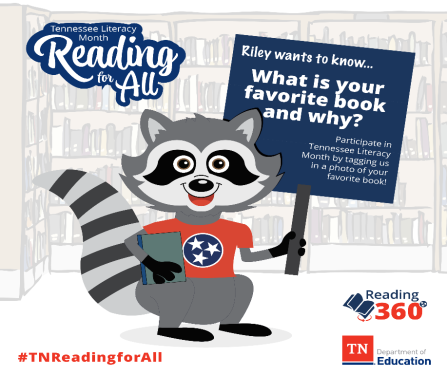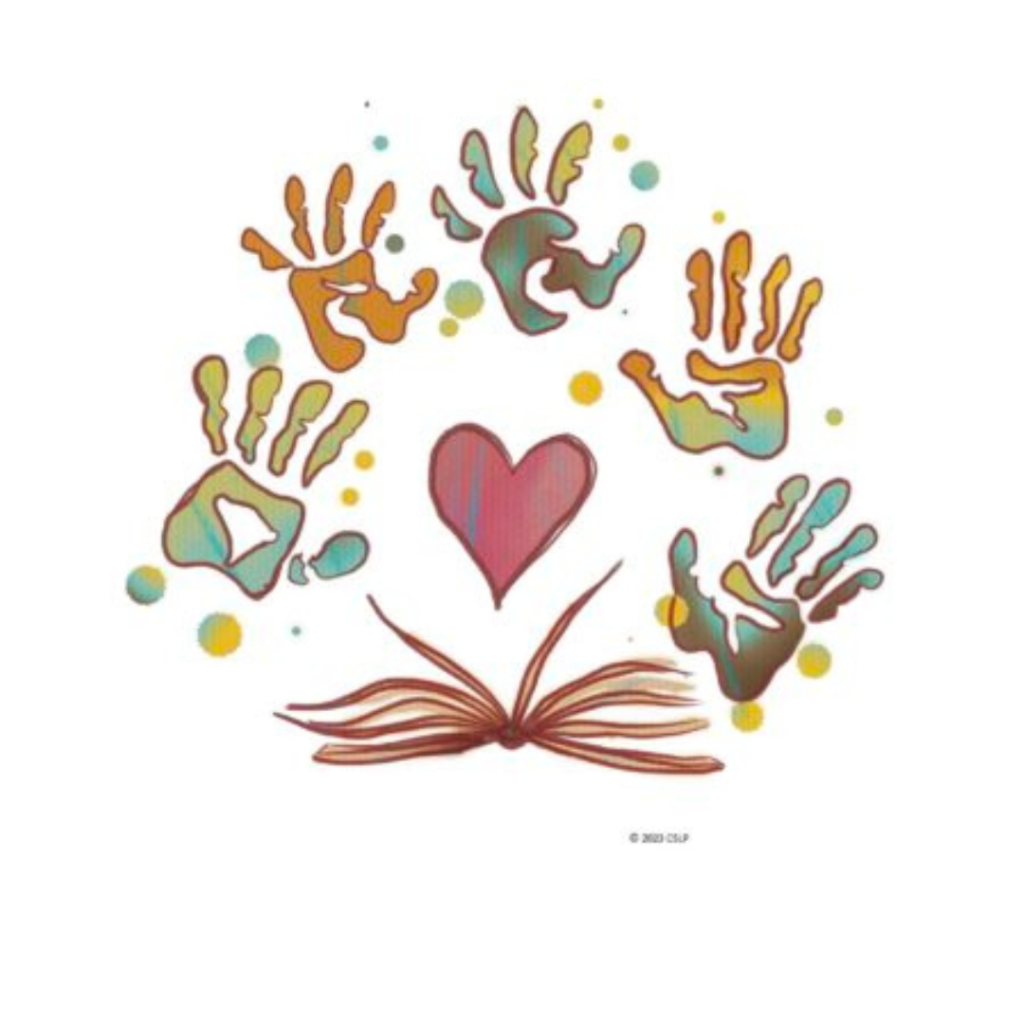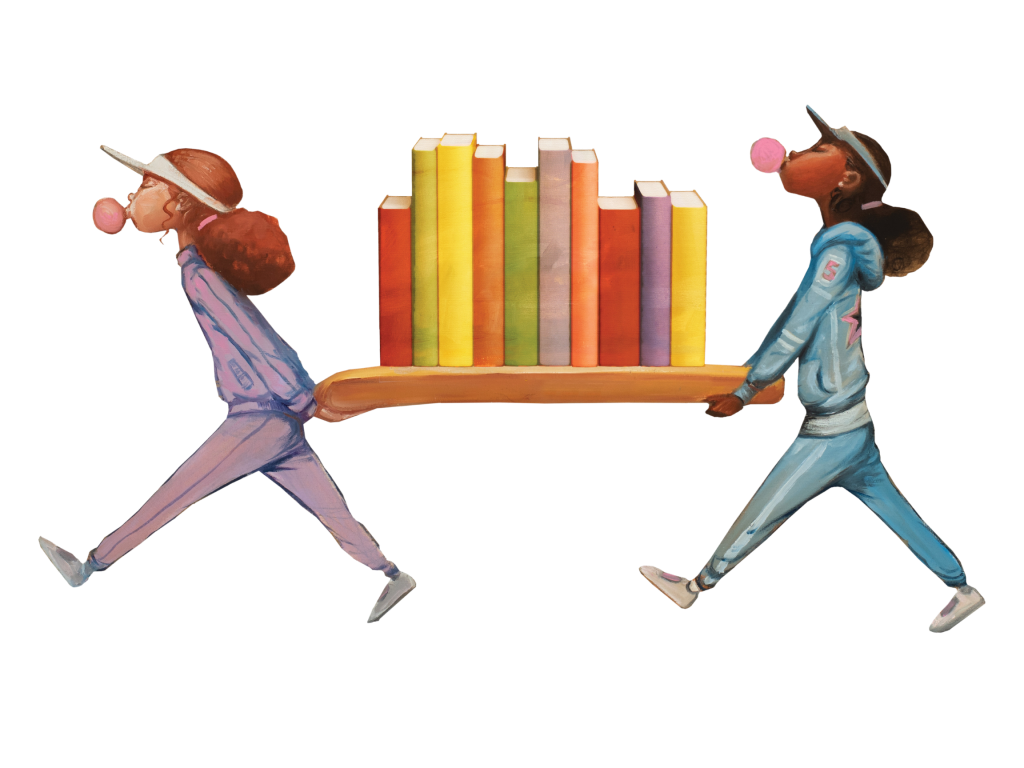Search Results for early literacy
📓September is Tennessee Literacy Month!
To highlight the importance of reading for students, the Tennessee Department of Education has introduced Reading 360, Tennessee’s comprehensive literacy initiative, which provides grants and resources for districts, teachers, and families looking to help students develop strong phonics based skills, or sounds-first instruction.
There are 92 Tennessee school districts participating in the Reading 360 Early Literacy Network, making them eligible for the $80,000 to provide direct support to school leaders and teachers.
Reading 360’s goal is to get all children reading by the 3rd grade. Penny Schwinn, the Tennessee Commissioner of Education states, “Tennessee is deeply committed to building strong reading skills in our youngest students, and Reading 360 has already reached 50,000+ families through free, at-home reading resources and 9,000+ Tennessee educators through summer literacy trainings.” One of those free resources is the At-Home Decodable Book Series– available for all Tennessee families of Kindergarten through Second grade children.
The department would also like families to meet Riley the Reading Raccoon, who shares their favorite books and favorite places to read. Families can follow Riley on social media using the hashtag #TNReadingForAll.
September 21-23, 2021 Reading 360 will hold a virtual summit that is free and open to all Tennessee educators, district and school leaders, higher education partners, and education stakeholders. This summit is designed to highlight best practices for the Reading 360 comprehensive literacy initiative.
Reference
Family Literacy and Tumblebooks
By Amy Shropshire, Reference Department
 Parents tend to want the best advantages for their children, and early literacy is one excellent advantage. That’s the idea, but getting a squirming toddler to sit still long enough to read a picture book demonstrates the difficulties involved. Even the best behaved children tend to struggle at some point with early literacy skills. Learning new skills is always difficult. The library is here to help.
Parents tend to want the best advantages for their children, and early literacy is one excellent advantage. That’s the idea, but getting a squirming toddler to sit still long enough to read a picture book demonstrates the difficulties involved. Even the best behaved children tend to struggle at some point with early literacy skills. Learning new skills is always difficult. The library is here to help.
According to the U.S. Department of Education, literacy is intergenerational. Parental involvement and expectations are directly linked to a student’s success in school. Family literacy programs often focus on building literacy skills in both parents and children. Parents that read regularly are more likely to have children with an interest in reading, since children like to emulate what their parents do. However, before a child can begin picking up a book, they need to gain pre-literacy skills, and be exposed to concepts that help develop literary skills.
We tend to think of reading as a singular activity, but in reality it’s a skill developed from assorted other skills as a child grows. Focusing on the little squiggly symbols we call letters is a step just as much as understanding how language works is. Learning to verbalize and consider abstract concepts through imaginative play and frequent communication are important building blocks to figuring out that squiggly symbols represent words. The more a child interacts and plays and expands their overall mental abilities, the quicker they will likely learn to read especially if play is already associated with words.
More than that, associating play with words is more likely to make a child enjoy reading (and want to learn more). Play is serious business for children. It may seem contradictory to learn using resources that don’t seem precisely educational, but the more fun the activity is the more information a child will absorb. Educators use a variety of resources to help children learn through play. One such resource is Tumblebooks. The library subscribes to this resource so that parents can log in and give their children access to a wide variety of books and games to aid in literacy development.
Many of the books on Tumblebooks play videos, sing songs, or animate highlighted words to allow children to follow along with the story on the screen. It may seem counter intuitive, but a child’s attention is often better with learning how to read by watching a video rather than simply reading a story, which develops early pre-literacy skills. The resources grow with the child using quizzes, book reports, and games for more developed readers, and even lesson plans for teachers and parents alike. There are also playlists of various lengths and subject areas to keep a child intrigued and entertained in a way that’s educational.
Tumblebooks is excellent for helping the youngest child gain early literacy skills before learning how to read. The library has multiple similar resources for various ages and literacy levels available in our collection databases. To access these resources, simply go to http://wcpltn.org/ Tumblebooks can be found in “Children’s Electronic Resources” which is located in the Children’s Department section under the “Main Library” tab on the website. If you can’t find it, just ask a librarian at (615) 794-3105. Tumblebooks does require a username and password to sign in. If you have any questions, call the library and we will gladly help you.
Resources:
https://www2.ed.gov/about/offices/list/ovae/pi/AdultEd/f14.html
https://www.tumblebooklibrary.com/Default.aspx?ReturnUrl=%2f
Library-based family literacy projects R 027.6 MON
Early literacy storytimes @ your library: partnering with caregivers for success 027.6251 GHO
Growing a reader from birth: your child’s path from language to literacy 372.4 MACG
Art across the alphabet: over 100 art experiences that enrich early literacy 372.5 CAM
The garden classroom: hands-on activities in math, science, literacy, and art 635.083 JAM
Discover, Learn, Play Room Open
Our new room, dedicated to children ages 0-5, opened on Tuesday, August 1, at the Main Library in Franklin.
The purpose of the new play & learn room is to promote early learning through play by creating family engagement experiences for children ages 0 – 5. Learn more: Franklin Library Opens New Play Area for Littles – Nashville Parent.
Thank you, Atmos Energy for the donation and support to help promote the importance of early literacy in our community.
Spotlight: Vanderbilt University🔦
The Williamson County Public Library Systems offers an annual summer reading program that is open to Williamson County citizens of all ages. The program is made possible due to the generous support of many local sponsors. In appreciation of their efforts, we would like to share with you a little bit of information about each sponsor.
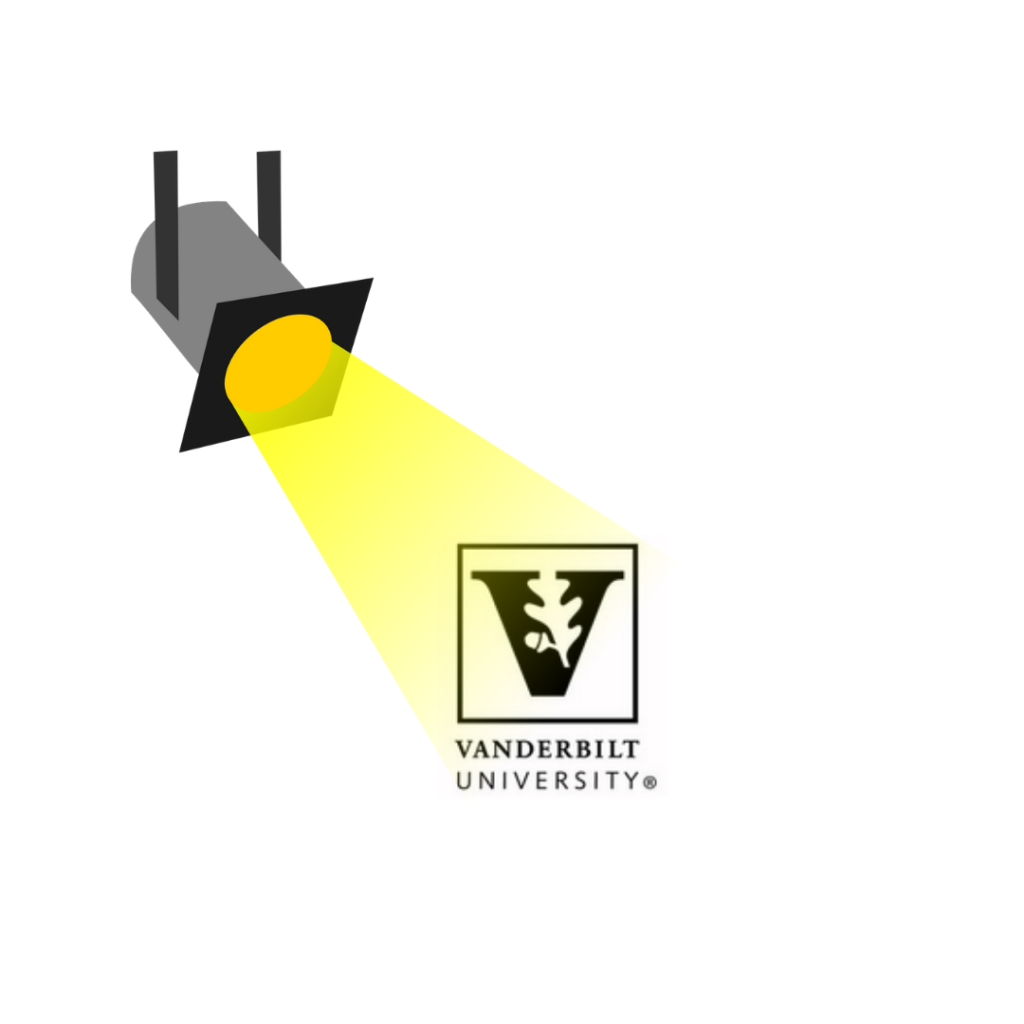
The Library’s foundational influence on reading and literacy is representative of the core values of Vanderbilt University. Recognizing the role of early literacy and the valuable impact it has on the community at large, Vanderbilt University is one of our educational sponsors.
Why Story Time Is Important
By Katy Searcy, Children’s Department
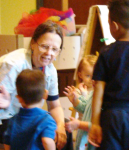 Here at WCPL, we host a variety of story times for young children: Snuggle Bug Lapsit Story Time for infants through eighteen months, Toddler Time for eighteen months to three years, and Preschool Story Time for three to five years. These story times are carefully planned and conducted by our children’s librarians using current early literacy research, and each story time is jam packed with fun and engaging age-appropriate stories, rhymes, songs, and aspects of play. And we absolutely LOVE story times! For me, story time is one of the highlights of my week, and I probably get way too excited about certain songs, rhymes, and books.
Here at WCPL, we host a variety of story times for young children: Snuggle Bug Lapsit Story Time for infants through eighteen months, Toddler Time for eighteen months to three years, and Preschool Story Time for three to five years. These story times are carefully planned and conducted by our children’s librarians using current early literacy research, and each story time is jam packed with fun and engaging age-appropriate stories, rhymes, songs, and aspects of play. And we absolutely LOVE story times! For me, story time is one of the highlights of my week, and I probably get way too excited about certain songs, rhymes, and books.
But why don’t I let you in on a little secret? As much as we love story times, we don’t do it because we love it so much or because that’s just what libraries are supposed to do. Actually, story times aren’t about us at all. Story times are all about YOU! Literacy begins at birth, and we know that it can be difficult to find time to figure out exactly what you’re supposed to do to help foster your child’s development. Hence, story times! We’re here to show you how you can introduce these early literacy skills to your little ones.
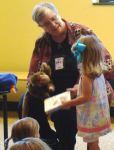 Still need convincing that story time is as awesome as I think it is? Luckily for you, I’ve listed several reasons why story time is important for children and parents.
Still need convincing that story time is as awesome as I think it is? Luckily for you, I’ve listed several reasons why story time is important for children and parents.
- Songs and rhymes are a great way for children to hear the sounds of language. Singing slows down language and allows children to hear the smaller sounds and syllables of words, which helps children sound out words when they learn to read.
- Children learn how books work as they listen to stories being read to them. They learn how to hold a book and turn the pages. Even when babies play with board books in ways we find unconventional (chewing, pulling, pushing, etc.), they’re developing print awareness, a skill research has shown is an important part of a strong foundation for reading.
- Books, songs, and rhymes help develop children’s vocabulary. The language used in books, songs, and rhymes is richer and uses different words than we use in conversation.
- Children can learn and develop their communication skills by interacting with other children and by watching their parents interact with other adults.
- As children have fun in story time, they learn to enjoy books. Children are more likely to stick with learning to read, even if it’s difficult, if they find books enjoyable.
- Children are exposed to different cultures and countries during story time, which broadens their horizons and adds to background knowledge that helps them understand what they read as they get older.
- Sitting still and listening to books during story time boosts children’s listening skills and helps them increase their attention span.
- Story time is great way to meet new people and make new friends.
- I’ll admit that libraries can be intimidating to navigate sometimes, and many older kids—and even adults—struggle to find what they’re looking for, ask for help, and check out books. Exposing children to the library when they’re younger ensures that they will know how to use a library.
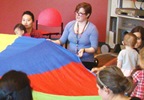
- Story time can be a great way to simply get out of the house. We don’t mind if you use us for a change of scenery.
So what are you waiting for? Come join us for story time!
Toddler Time (18 months to 3 years): Tuesdays, 10:00 am and 11:15 am
Preschool Story Time (3 to 5 years): Wednesdays and Thursdays, 10:00 am
Snuggle Bug Lapsit Story Time (birth to 18 months): Fridays, 10:00 am
Sources:
- www.earlylit.net/s/whatcansaycompprac.doc
- http://www.rif.org/blog/ten-benefits-of-storytime/
- http://www.libraryadventure.com/10-reasons-why-you-should-go-to-story-time/
How to Teach Your Baby to Read by Glenn and Janet Doman
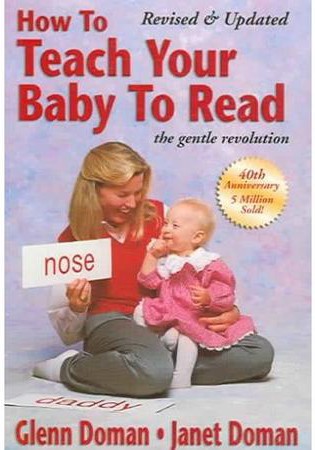 By Liz Arrambide, Children’s Librarian
By Liz Arrambide, Children’s Librarian
Occasionally families ask us what books do we have to teach very young children how to read. Most of the books we carry are designed for older children. Megan Sheridan has written an excellent article on this blog explaining fun ways to teach basic early literacy skills.
For families that want to teach their young children (under age six) how to read there is an excellent book: “How to Teach Your Baby to Read: the gentle revolution” by Glenn Doman and Janet Doman. Glenn Doman and his research team started in the 1950’s to see what they could do to help children with brain injuries increase their capacity to learn. The researchers learned that their methods helped the children to learn to read. They were surprised to find that a brain damaged child could read at ages three and four when their peers could not.
The institutes for the Achievement of Human Potential began to theorize that very young children seem to be learning differently than children who are six years or older. A child learns language by being shown an object and then being told the name of the object. The team experimented and found that this type of learning can be extended to teaching a child to read. Very young children can learn that the sound ”ball”, a physical ball and the word “ball” all mean the same thing. Their in-depth research showed that this facility of the brain disappears at age six.
As a young mother, I was intrigued with this book. I tried their methods with my then two and half year old child. We had a lot of fun and she learned to read really well. When she started Kindergarten, she tested at a third grade reading level. I’ve tutored others in reading since then. It was much easier for my daughter to learn to read using this method. She didn’t have to be taught about “consonant blends” or the “er” sound etc. She didn’t go through these stages. For interested families, this revised edition offers a fun and easy way to teach very young children to read.
Read to Your Child: Doctor’s Orders!
By Megan Sheridan, Children’s Librarian
Has your child’s doctor told you to read to your little one? If not, maybe you’ve heard about this; the American Academy of Pediatrics has advised pediatricians to urge parents and caregivers to read to their children (read the article). Why are some doctors doing this? It’s because reading to children, especially ages 0 to 5, plays a crucial role in preparing them for success in school and in life. Reading to very young children is not about teaching them to read but getting them ready to read. The American Library Association (ALA) has built a program around this concept called Every Child Ready to Read (ECRR). As more and more data about the importance of Early Childhood Literacy has been published and analyzed, groups like The American Academy of Pediatrics and others are urging caregivers to read to their children.
You might be overwhelmed or even intimidated when an article, book or doctor tells you to read to your child. You might wonder “what books should I read to my little one(s)?” and “How do I prepare my child for Kindergarten?”
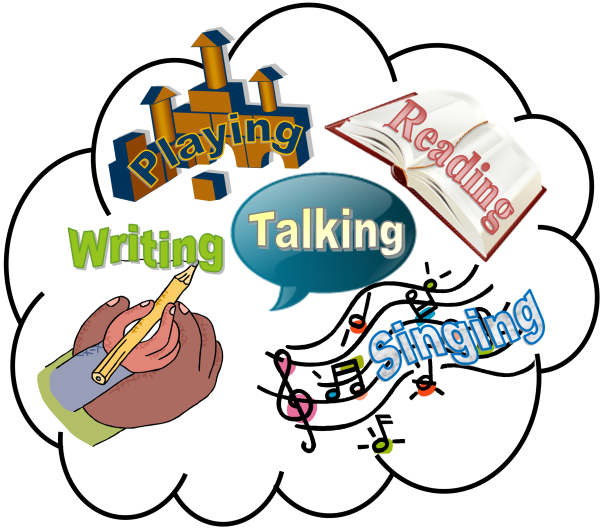
Created by Rebecca Tischler
If you’ve asked yourself these questions; don’t worry! You’re probably already doing many things to get your child ready to read and if you’re not, it’s easy to start and never too late.
There are five activities to develop your child’s early literacy skills: Talk, Read, Sing, Write and Play. For a quick explanation of these activities and examples of how to do them visit this website from the Hennepin County Library in Minnesota. The five activities can be done in your daily routine. For example, simply talk to your child about the world around you and the activities you do every day. Talk about how pretty the white clouds are in the sky and how the cozy the blanket is. Don’t feel silly talking to your newborn when you’re changing her diaper or getting her bottle ready. The more your child hears you talk the more words she’ll learn and this is vital for early childhood literacy development.
If you, like most parents and caregivers, feel stretched for time and have a busy life, you might not get as much time to read with your children as you would like. That’s okay because you can still do reading activities without a book! Read street signs out loud as you pass them by in the car when your little one is in the back seat. Look at cereal boxes in the grocery store and read the names of the cereal out loud. Do this for infants too, and not just for toddlers and preschoolers.
By talking, reading, singing, writing and playing with your child every day she will not only be prepared for school and life but you will have fun together. And that’s one doctor’s order that is easy to follow!
Resources:
- To find examples of great books to read to your child, visit Let’s Read on the Williamson County Public Library website and click on toddler and pre-school tabs on the right. This will bring up lists of books that are just right for children in the 0 to 5 range. We also have board books which are wonderful for babies and toddlers. Believe it or not, by giving your baby or toddler a board book and letting her play with it you’re getting her ready to read! Your baby is learning how to hold the book and turn the pages. These are the building blocks of literacy and it’s never too early to start teaching them to your baby. She might even put the book in her mouth and that’s okay! That’s how babies learn about the world around them.
-
Zero to Three has some great information about how to choose a book for babies, toddlers and families. There is also a more in depth explanation of early language and literacy development on their website.
- For more ideas on how to develop early literacy skills download the ACPL Family app, which is FREE! It has wonderful examples of how to do the five early literacy activities every day.
- The Library of Virginia has an easy to understand visual of the five Early Literacy activities. An image of a sun and a tree is used to illustrate the components of Early Childhood Literacy. The caregiver is the sun. He or she makes the difference in a child’s early literacy development. The fruit of the caregiver’s interactions with a child, of doing the five activities together, is that she will find it easier to learn to read. Click here for more explanation:
Reader’s Advisory Websites for Kids
By Katy Searcy, Children’s Department
Looking for a great book to get your kids excited about reading? Do you have a picky reader who absolutely must only read one particular genre? Maybe you have a kid on your hands who just read the best book ever and needs something else that’s just as good. Sure, you could go to Goodreads, but sometimes their suggestions aren’t exactly what you’re looking for. You could also ask us, your friendly neighborhood librarians here at WCPL who are very familiar with our collection and would be more than happy to recommend you the perfect book. But admittedly, there are likely some gaps in our vast book knowledge, so here are five websites full of great book suggestions for kids.
Guys Read
 Guys Read is a web-based literacy program founded by children’s author Jon Scieszka. Their mission is to encourage boys to become self-motivated, lifelong readers by helping them find books they’re interested in. This website has collected lists of books recommended by teachers, librarians, booksellers, publishers, parents, and other guys and grouped them into categories to make them easier to find. From “Creepy and Weird” to “For Little Guys” to “Robots” to “Classics That Actually Hold Up,” guys of all ages can find exactly what they’re looking for in a book, and if they find one they like, there are further recommended titles under each book suggestion.
Guys Read is a web-based literacy program founded by children’s author Jon Scieszka. Their mission is to encourage boys to become self-motivated, lifelong readers by helping them find books they’re interested in. This website has collected lists of books recommended by teachers, librarians, booksellers, publishers, parents, and other guys and grouped them into categories to make them easier to find. From “Creepy and Weird” to “For Little Guys” to “Robots” to “Classics That Actually Hold Up,” guys of all ages can find exactly what they’re looking for in a book, and if they find one they like, there are further recommended titles under each book suggestion.
A Mighty Girl
 Similar to Guys Read, A Mighty Girl prides themselves on having “the world’s largest collection of books, toys and movies for smart, confident, and courageous girls,” and their impressive book section features over 2,000 girl-empowering books to choose from. Their best feature is easily the over 200 book categories available to explore, where books are grouped by character (from books, television, movies, and historical figures), genre, social issues, personal development, topic, and age.
Similar to Guys Read, A Mighty Girl prides themselves on having “the world’s largest collection of books, toys and movies for smart, confident, and courageous girls,” and their impressive book section features over 2,000 girl-empowering books to choose from. Their best feature is easily the over 200 book categories available to explore, where books are grouped by character (from books, television, movies, and historical figures), genre, social issues, personal development, topic, and age.
The Best Children’s Books
 The Best Children’s Books is curated by teachers who understand how important it is to find good books for children, and the books featured on this website are books that they use and recommend in their classrooms. For the most part, books recommended here are geared toward ages four through twelve. With blurbs describing how exactly books can be used, there is definitely more of a focus on classroom use, but this website could be an excellent resource for homeschooling families, teachers, or anyone needing a book for a particular report topic.
The Best Children’s Books is curated by teachers who understand how important it is to find good books for children, and the books featured on this website are books that they use and recommend in their classrooms. For the most part, books recommended here are geared toward ages four through twelve. With blurbs describing how exactly books can be used, there is definitely more of a focus on classroom use, but this website could be an excellent resource for homeschooling families, teachers, or anyone needing a book for a particular report topic.
Bank Street College of Education Book Lists
 Bank Street College of Education Library excels at creating book lists. From “STEM” to “Back to School” to “Read Alouds for Children Twelve and Over,” there is a list on nearly any topic featuring a diverse array of characters and stories. If you have the time, I would definitely recommend browsing their Best Books of the Year list that features a whopping 600 titles broken down by age range.
Bank Street College of Education Library excels at creating book lists. From “STEM” to “Back to School” to “Read Alouds for Children Twelve and Over,” there is a list on nearly any topic featuring a diverse array of characters and stories. If you have the time, I would definitely recommend browsing their Best Books of the Year list that features a whopping 600 titles broken down by age range.
Books & Authors
![]() Books & Authors is a database available through the library that provides recommended read-a-likes and an extensive selection of genres and authors to browse. You can even create lists of books you may come across that you want to save for later.
Books & Authors is a database available through the library that provides recommended read-a-likes and an extensive selection of genres and authors to browse. You can even create lists of books you may come across that you want to save for later.
Once you’ve found a book to read, search our catalog for it and put it on hold, or give us a call for us to put it on hold for you. If we don’t have it in our collection, we can get most books from interlibrary loan. Now go forth and discover your new favorite book!

